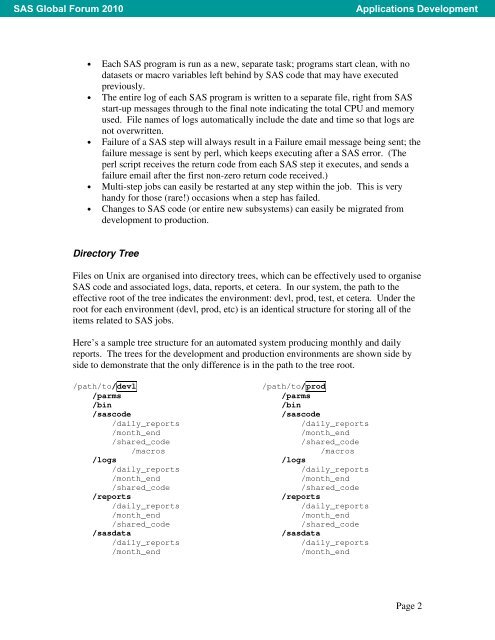A Robust and Flexible Approach to Automating SAS® Jobs Under ...
A Robust and Flexible Approach to Automating SAS® Jobs Under ...
A Robust and Flexible Approach to Automating SAS® Jobs Under ...
You also want an ePaper? Increase the reach of your titles
YUMPU automatically turns print PDFs into web optimized ePapers that Google loves.
SAS Global Forum 2010<br />
Applications Development<br />
• Each SAS program is run as a new, separate task; programs start clean, with no<br />
datasets or macro variables left behind by SAS code that may have executed<br />
previously.<br />
• The entire log of each SAS program is written <strong>to</strong> a separate file, right from SAS<br />
start-up messages through <strong>to</strong> the final note indicating the <strong>to</strong>tal CPU <strong>and</strong> memory<br />
used. File names of logs au<strong>to</strong>matically include the date <strong>and</strong> time so that logs are<br />
not overwritten.<br />
• Failure of a SAS step will always result in a Failure email message being sent; the<br />
failure message is sent by perl, which keeps executing after a SAS error. (The<br />
perl script receives the return code from each SAS step it executes, <strong>and</strong> sends a<br />
failure email after the first non-zero return code received.)<br />
• Multi-step jobs can easily be restarted at any step within the job. This is very<br />
h<strong>and</strong>y for those (rare!) occasions when a step has failed.<br />
• Changes <strong>to</strong> SAS code (or entire new subsystems) can easily be migrated from<br />
development <strong>to</strong> production.<br />
Direc<strong>to</strong>ry Tree<br />
Files on Unix are organised in<strong>to</strong> direc<strong>to</strong>ry trees, which can be effectively used <strong>to</strong> organise<br />
SAS code <strong>and</strong> associated logs, data, reports, et cetera. In our system, the path <strong>to</strong> the<br />
effective root of the tree indicates the environment: devl, prod, test, et cetera. <strong>Under</strong> the<br />
root for each environment (devl, prod, etc) is an identical structure for s<strong>to</strong>ring all of the<br />
items related <strong>to</strong> SAS jobs.<br />
Here’s a sample tree structure for an au<strong>to</strong>mated system producing monthly <strong>and</strong> daily<br />
reports. The trees for the development <strong>and</strong> production environments are shown side by<br />
side <strong>to</strong> demonstrate that the only difference is in the path <strong>to</strong> the tree root.<br />
/path/<strong>to</strong>/devl<br />
/parms<br />
/bin<br />
/sascode<br />
/daily_reports<br />
/month_end<br />
/shared_code<br />
/macros<br />
/logs<br />
/daily_reports<br />
/month_end<br />
/shared_code<br />
/reports<br />
/daily_reports<br />
/month_end<br />
/shared_code<br />
/sasdata<br />
/daily_reports<br />
/month_end<br />
/path/<strong>to</strong>/prod<br />
/parms<br />
/bin<br />
/sascode<br />
/daily_reports<br />
/month_end<br />
/shared_code<br />
/macros<br />
/logs<br />
/daily_reports<br />
/month_end<br />
/shared_code<br />
/reports<br />
/daily_reports<br />
/month_end<br />
/shared_code<br />
/sasdata<br />
/daily_reports<br />
/month_end<br />
Page 2
















